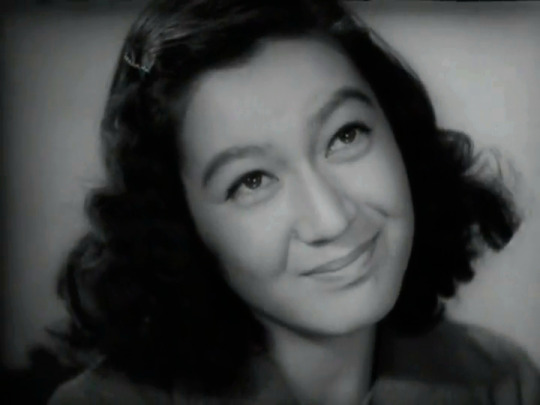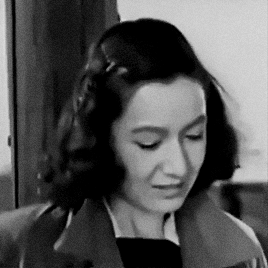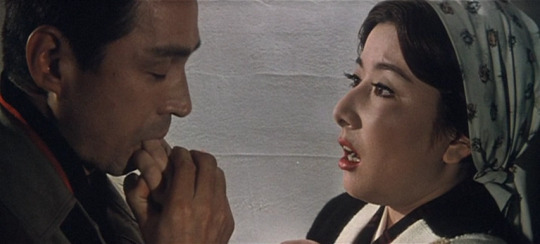#kozaburo yoshimura
Text


Setsuko Hara in Temptation | 誘惑 (1948) dir. Kōzaburō Yoshimura
33 notes
·
View notes
Text



Setsuko Hara in The Ball at the Anjo House || 安城家の舞踏会 (1947) dir. Kōzaburō Yoshimura
#setsuko hara#the ball at the anjo house#kozaburo yoshimura#classicfilmcentral#classicfilmsource#cinemaspast#japanese movie#filmgifs#ellisgifs#shgif#the original vid was so lq 😢#release a restoration you cowards
90 notes
·
View notes
Text

Ginza no onna (1955), directed by Kozaburo Yoshimura (September 9, 1911 – November 7, 2000).
4 notes
·
View notes
Text




The Tale of Genji (Kozaburo Yoshimura, 1951)
6 notes
·
View notes
Photo

Nobuko Otowa as Princess Taema in “The beauty and the dragon”, Kozaburo Yoshimura, 1955
411 notes
·
View notes
Text

Lobby card for The Tale Of Genji (源氏物語), 1951, directed by Kozaburo Yoshimura (吉村公三郎) and starring Machiko Kyo (京マチ子).
31 notes
·
View notes
Photo





Yoru no kawa aka River of the night, 1956, Kozaburo Yoshimura
30 notes
·
View notes
Photo

The Ball at the Anjo House (Kôzaburô Yoshimura, 1947)
#The Ball at the Anjo House#Kôzaburô Yoshimura#yoshimura#quote#comedy#dreams#kozaburo yoshimura#Anjô-ke no butôkai#anjo-ke no butokai#Takashi Kanda#black and white#1947
602 notes
·
View notes
Photo

The Ball at the Anjo House (Anjô-ke no butôkai, 1947) - Kozaburo Yoshimura
#Kozaburo Yoshimura#kaneto shindo#setsuko hara#Masayuki Mori#smoking#japanese cinema#japanese film#animated gif
17 notes
·
View notes
Photo



越前竹人形 (1963) · Kozaburo Yoshimura
#bamboo doll of echizen#kozaburo yoshimura#tsutomu minakami#echizen take-ningyô#ayako wakao#junichiro yamashita
75 notes
·
View notes
Text

Setsuko Hara in Temptation | 誘惑 (1948) dir. Kōzaburō Yoshimura
23 notes
·
View notes
Text




Setsuko Hara in Temptation | 誘惑 (1948) dir. Kōzaburō Yoshimura
#temptation#setsuko hara#Kōzaburō Yoshimura#temptation 1948#yukawa#kozaburo yoshimura#japanese movie#ellisgifs#shgif#flickering tw#another day..another episode of ‘giffing setsuko hara in every film i watch her in despite the videos only being the absolute worst quality#360 and unrestored……#why do I subject myself to this :(#i want to do a nice set of her in this film but i can only find it in The Worst quality :((((((#queue
14 notes
·
View notes
Text
Jokyō (女経, A Woman’s Testament, 1960) by Kozaburo Yoshimura, Kon Ichikawa, Yasuzo Masumura

Jokyo is a 1960 Japanese anthology film, one of a few examples of this genre from the years of Golden Age of Japanese cinema. Three novels are shot by different directors Kozaburo Yoshimura, Kon Ichikawa, and Yasuzo Masumura and tied together by a theme of a strong woman who had discredited the men and learned not to trust them, under any circumstances.

The first story by Yoshimura depicts a female protagonist Kimi in quite an unpleasant light. She works in a club squeezing money from all the men approaching her. She excels in cynism and decayed moral. The motivation and background of Kimi played Ayako Wakao remain unclear causing no sympathy to her. Kimi is a sort of courtesan, and this is tribute Yoshimura pays to one of the most prominent themes of Japanese Golden Ages films. For instance, it has been one of the most significant themes for the acclaimed classic of Japanese cinema Kenji Mizuguchi. Ayako Wakao played a similar character in Mizuguchi’s final film Street of Shame. Though, in that film, her motivation was pretty much understandable. She’s been living with other geishas for years hoping to buy her way out of business. Very few women were able to do that, but Wakao’s character was shown very smart, emotionally stable and down-to-earth. Street of Shame was a poignant drama of geishas, while Yoshimura’s short film just tells heroine’s fiancée had dumped just before the wedding. So she ended up this way hating the men and thinking they are not worth any consideration and trust. It is certainly true in many situations, but Kimi doesn’t radiate anything positive. The viewers can express respect to her sense for business, but it is not quite clear why she ended up this way and why all the other women around are also shown to illustrate such way of interaction between men and women is the only thing that works out. Of course, 10 years back women in Japan had no chance to live the life as Wakao’s character lives so it’s a good thing she can be independent. But from the other hand, the entire idea is quite bleak, and at some point, it seems like director conveys that men always lie to women, and women are meant to scam them in return. And that’s about it, there is no alternative.

Even though I was not really fond of the first story, I must say Ayako Wakao always colours me amazed of her roles, and this case was no exception. She is one of the most outstanding leading ladies of the late Japanese Golden Age.

The second story shot by Kon Ichikawa brings a different tone. Kon Ichiwaka casts here another shining star of Japanese cinema of the 1950-s and one of his favourite actresses who collaborated with him several times – 1950 Miss Nippon Fujiko Yamamoto. In cinema industry, she’s primarily known for her role in Yasujiro Ozu’s Higanbana, but from my point of view in this film, she has one of her most stellar roles. Yamamoto portrays a woman agent tricking men into buying an expensive property. With elaborate decoys, she makes the men fall in love with her and convince them to help her buying the things belonging to her husband who passed away (though, the property belongs to the agencies she works for). In this story, she meets a writer who seemingly falls under her charm too and buys an almost rundown house for a huge amount of money. Later, the plot twists and the viewers come to know that the writer knew initially about the woman’s plan and decided to keep playing this game. A character portrayed by Yamamoto is adorable, mesmerizing, enthralling and tantalizingly enchanting. However, despite her nasty business she appears to be the type who just hasn’t met her love yet, but she is not as cynical as a character played by Ayako Wakao in the first novel. This story ends happily with the characters meeting each other and realizing they have nothing for each other, but joint affinity. The performance and emotions of one of the most beautiful Japanese actresses Fujiko Yamamoto make this story visually wonderful. Also, a short appearance of Hitomi Nozoe in one of her first roles in the cinema is very remarkable. She would get her spot of the top star of Japanese cinema later than the Golden Age faded away.

The third story is directed by Yasuzo Masumura. This novel stars a famous kabuki actor Ganjiro Nakamura famous for his roles in Ozu’s Floating Weeds, The End of Summer and many other famous Golden Age Japanese films. Also, it stars Rashomon’s star Machiko Kyo who played in a duo with Nakamura several times before this film. Machiko Kyo’s roles of the 1960-s are often even much impressive than her breakthrough performances of the early 1950-s. In Masumura’s novel, she plays a former geisha Omitsu who is currently a businesswoman. She has money now, yet she lacks happiness and emotional connections with people. As she gets older, she loses the hope to be happy with someone since she had learned the women should not trust men. This is what she tells her younger relative, a girl who intends to get married. Omitsu has been through many problems and social pressure during her life, and she tries to teach the young girl in a skeptical manner. However, in the end, she realizes that the young people are very vivid and passionate and they are supposed to experience ups and downs themselves. Eventually, she gives up agreeing to finance the future wedding and says one day she hopes to be happy in a family as well. The subplot with a schoolboy meeting an accident also helps her to soften her feelings and attitude. She is shown as a very experienced and strong woman who doesn’t interfere with the other lives, though. And I really liked this character Machiko Kyo plays in the story.

All-in-all, Jokyo tells three very different stories of women of a new Japanese generation who have been raised on the necessity to be strong and independent. This theme is crucial for the films of Japanese Golden Age of the 1950-1960-s as the social behaviour and roles of genders in social construct change radically in Japan at this time. This theme has been pivotal for Ozu, Mizoguchi, Mikio Naruse, Masaki Kobayashi and other famous Japanese masters of the Golden Age.

#jokyo#女経#kozaburo yoshimura#kon ichikawa#yasuzo masumura#Ayako Wakao#若尾 文子#fujiko yamamoto#山本 富士子#Machiko Kyo#京 マチ子#Ganjiro Nakamura#中村鴈治郎
8 notes
·
View notes
Text


Jokyo (1960)
#Machiko Kyo#Kozaburo Yoshimura#Jokyo#1960#Ganjiro Nakamura#Japanese movie#Japanese film#Kyo Machiko#京マチ子#吉村公三郎#中村鴈治郎#女経#日本映画#1960年代#1960年#恋を忘れていた女
1 note
·
View note
Photo

Lobby card for The Age Of Marriage (Konki, 婚期), 1961, directed by Kozaburo Yoshimura (吉村公三郎) and starring Ayako Wakao (若尾文子), Machiko Kyo (京マチ子), Keiko Yumi (弓恵子), Hitomi Nozoe (野添ひとみ) and Mieko Takamine (高峰三枝子).
#Ayako Wakao#Machiko Kyo#Kozaburo Yoshimura#Konki#The Age Of Marriage#婚期#吉村公三郎#若尾文子#京マチ子#Keiko Yumi#弓恵子#Hitomi Nozoe#野添ひとみ#Mieko Takamine#高峰三枝子#Daiei#lobby card
40 notes
·
View notes
Photo








Yoru no kawa aka River of the night, 1956, Kozaburo Yoshimura
12 notes
·
View notes